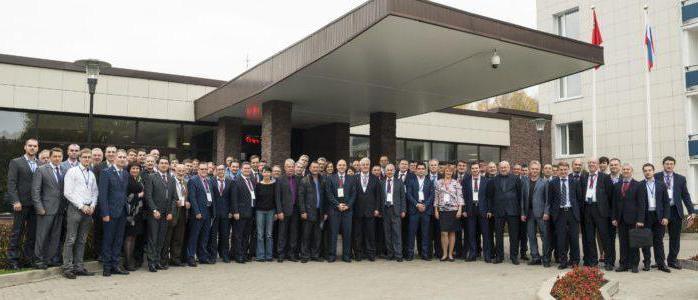In today's world, people enter into a variety of relationships. They interact both directly and through various groups. In the latter case, people are united by a common interest, goal, task. Groups can be formalized or informal. The latter do not imply any formalization of activities.
Formalized groups receive the status of a legal entity, branch, representative office. Their activities are regulated by the Civil Code. Consider further what exist Forms of legal entities in the Russian Federation. 
Definition
It is given in article 48 of the Civil Code. As the norm indicates, a legal entity is an association that has, in economic jurisdiction, ownership, operational management, a certain separate property, with which it meets its obligations, is able to obtain and exercise property and non-property rights from its own person, act as a defendant / plaintiff in court, bear responsibilities. This wording presents the main criteria that a formalized society must meet.
Characteristic features
Any types and forms of legal entities must meet the criteria established by article 48 of the Civil Code. These include:
- The presence of separate property. As stated in the norm, material assets may be in operational management, ownership or economic management. Property should be accounted for on an independent balance sheet.
- Separation of responsibility. Participants are not liable for the obligations of the company, and it, in turn, - for their debts. Exceptions may be established only by law.
- Independent participation on its own behalf in civil law relations. These include, inter alia, the acquisition and exercise of non-property and property rights, the fulfillment of obligations provided by law.
- The availability of the opportunity to protect interests by legal means. This sign indicates the right of society to be a plaintiff or defendant.
- Availability of a document confirming official registration. As it acts the certificate of the established sample.
Classification
The criteria for dividing associations into categories are:
- The purpose of the activity. It may consist in making a profit, for example. The legislation allows the formation of associations for other purposes not related to business.
- Form of incorporation of a legal entity. it legal types of enterprises established by law.
- The nature of the relationship between the association and its members. In this case, the presence / absence of the founders' right of ownership of the contributions that they make to the property of the company is of importance.
purpose
Depending on the result that the entities want to achieve, associations can be commercial and non-commercial. The activities of the latter are not related to entrepreneurship. At the same time, they can make a profit, but it cannot be divided between the participants. Accordingly, the purpose for which are created commercial forms of legal entities, associated with generating income. In the legal sense, the difference between these associations is only in the order of profit distribution. Commercial entities are required to share the income between the participants. The procedure in accordance with which the distribution of funds takes place is established by the accounting policy. 
Forms of legal entities (commercial organizations)
The legislation provides for two main groups of associations:
- Society.They are formed by pooling capital.
- Partnerships. These enterprises are created by bringing people together.
- Unitary enterprises.
- Cooperatives.
Each group also provides for the separation of enterprises. The criterion is legal entity. it separation provides the ability to most effectively control the activities of business entities in the market.
Full partnership
This group has two forms of legal entities. The first is full partnership. He recognizes such an association, the participants of which, according to the memorandum of association, conduct business on his behalf and are liable with his property for his obligations. The corresponding definition is disclosed in article 69 of the Civil Code. There are several signs that this legal form of a legal entity. it:
- As a full partner, another company or individual entrepreneur may act. Moreover, they are not entitled to become participants in another such association or partnership in faith.
- The constituent document is the contract.
- The company name should include the names (names) of all participants and the phrase "full partnership". Some names may be indicated, to which the words "and company" are added. In this case, the phrase "full partnership" must be present.
- Businesses are conducted by the participants themselves. This means that each full partner has the right to make transactions on behalf of the association. The memorandum of association may also be fixed in a different order.
Faith Partnership
It is also called "limited." For this flegal entities The following symptoms are characteristic. Along with the main participants who conduct business on behalf of the association and are responsible for the obligations of the enterprise with their property, there is one (or several) investors in the composition. They are called commandists. These depositors bear the risks of losses that are possible when the enterprise carries out its activities, within the framework of the amounts they have contributed. Commandists do not participate in the partnership. In other aspects, the legal status of this forms of legal entities identical to full partnership status.
Ltd
The legislation also provides for such organizational forms of legal entitiesas a society. One of them is LLC. For this forms of legal entities The following symptoms are characteristic:
- An association is established by one or more entities.
- Upon creation, the authorized capital is formed. It is divided into shares. Their value is determined by the constituent documents.
- Participants are not liable for the obligations of the association. However, they bear the risk of financial losses associated with the operation of the enterprise, in the framework of the value of their contributions.
- The number of participants should be no more than 50.
The constituent documents are the charter and the contract. The company name of the association must contain an indication of the legal form. 
ODO
This legal entity organization form has a certain specificity. An ODL is created in the same way as an LLC - by one or more entities. In the first case, however, participants bear subsidiary liability for the obligations of the association jointly and severally with their property in an amount multiple of the value of deposits. Otherwise, the legal status of the ODL is identical to the status of the LLC.
AO
This is an association in which the share capital is divided into a certain number of shares. Participants are not liable for obligations assumed by the company, however, they bear the risk of losses from the activities of the enterprise within the framework of the value of their securities. The founding document in AO is one - the charter.
Types of AO
A joint stock company may be open or closed.The first has the right to publicly subscribe to the papers that it issues. Participants, in turn, may alienate their shares without the consent of the remaining shareholders. OJSC is obliged to publish annually a report, loss and profit statement, balance sheet and other information. This information should be freely available. The maximum number of participants in a company is not limited by law. A CJSC is entitled to distribute shares only among founders or entities, the circle of which is determined in advance. Participants have the preemptive right to purchase securities of other founders.
Production cooperative
It is an association of citizens on a voluntary basis and on the basis of membership. The purpose of creating a cooperative is a joint production or other economic activity. In its implementation, members of the cooperative personally participate in a labor or other process. When creating a cooperative, property contributions (units) are combined. Legal entities can also act as participants if the corresponding right is enshrined in the charter of the production association. The number of cooperative members should not be less than 5. At the same time, the number of persons not participating in industrial or other economic activities may not exceed 25% of those performing labor duties.
Unitary enterprises
Another criterion for separating associations is legal entity ownership. Private companies were considered above. In practice, unitary enterprises are quite common. They can be state or municipal. This form of ownership of a legal entity assumes that the property that the association is using does not belong to him. The company does not have the right to dispose of objects, to distribute it among deposits, shares, shares, including among employees. The owner is the municipality or state. The property is transferred to the enterprise in operational management or economic management. 
Bodies of legal entities
In LLC as the highest governing structure acts the general meeting. It addresses all issues related to the activities of the association. The competence of the meeting includes the election of a collegial or sole executive body. The joint-stock company also decides all issues at the meeting. It selects a board of directors that acts as a supervisor. In addition, there are also executive bodies (sole or collective) in the joint-stock company. In a production cooperative, the management structure is a meeting of members. It selects a supervisory board (if the number of participants is more than 50), as well as executive bodies.
Other categories
Non-profit legal entities include consumer cooperatives. They are created by citizens who have combined share contributions to realize their property and other interests. Consumer are housing, garage, country and other cooperatives. Another form of non-profit is religious and public organizations. They are created voluntarily by citizens. Individuals are united by common interests, spiritual or other intangible needs. Religious organizations are formed for joint confession, the spread of faith. Their members conduct a variety of ceremonies, teaching classes. Another form of legal entity is the foundation. It is not created on the basis of membership. The Fund is established by legal entities or citizens who invest their funds.
The association is created to implement cultural, charitable, social, educational and other socially useful tasks. Liquidation of the fund is possible only through the court. Institutions are legal entities formed by the owner to perform non-profit functions. They are financed by him in whole or in part. The property is transferred to the institution in operational management.Unions / associations are associations of non-profit or commercial legal entities. They provide coordination of the activities of enterprises and the protection of their interests. Thus, knowing the general characteristics of associations, founders can choose what form of legal entity suits them. 
Legal requirements
As a prerequisite for the implementation of the activities of the association of any type acts registration of a legal entity. The form The statements are unified. The filled in form P11001 is submitted to the authorized authority. Before the procedure, the association must prepare:
- Charter.
- Creation Agreement (if there are more than 2 founders).
- Minutes of the meeting or decision.
- Duty receipt.
In addition, you must select the OKVED codes, as well as the taxation system.
Nuances
For the LLC since 2009, the foundation agreement must contain information about:
- Face value and size of shares in the capital.
- The date of payment of contributions by participants.
Previously, this information should have been present in the charter. She is currently excluded from it. If the legal entity intends to use the simplified tax system, then two copies of the corresponding application can be attached to the set of documents (f. 1150001). 
Possible difficulties in practice
In some cases, reorganization may be required during the course of an association. This concept is disclosed in article 57 of the Civil Code. The norm states that reorganization can be carried out by merger, transformation, accession, separation, separation. At the same time, when carrying out any of these procedures, a new association is formed. It is possible to carry out reorganization on the basis of the decision of the participants or the authorized body of the legal entity. Of particular interest in practice is the transformation. As Article 58 of the Code points out (paragraph 5), a change in the form of a legal entity involves the preservation of the duties and rights of the reorganized association in relation to other entities except participants. According to the 66th norm of the Civil Code (Clause 3), in force before the entry into force of the Federal Law No. 99, business entities can be formed as AO, LLC, ODO. A joint-stock company, in turn, can be transformed exclusively into a production cooperative or LLC. Accordingly, these changes to the legal entity form will be recognized as a reorganization. If in the name instead of the abbreviation OJSC is used AO or PAO, the enterprise remains joint-stock. These changes in the name of its organizational form do not affect. Accordingly, they are not recognized as a reorganization.
Additionally
It should be noted that any changes must be documented. Legislation requires meetings and formal decisions. Documents approved by the participants are submitted to the registration authority. Based on the decision, adjustments are made to the charter and other local documents. Information about all changes must be present in the registry. 
Public education
Current legislation extends the rules governing the participation of legal entities in civil relations to another category of associations. They are public entities. For their obligations, they are responsible with their own property, except for the objects assigned to the legal entities created by them as operational management / households. reference, as well as material assets, which may be exclusively in municipal or state property. Public entities are not liable for each other's debts. It is not provided for in relation to the obligations of legal entities created by them. An exception is cases that are expressly established by law. Responsibility is also provided for in situations where public education provides guarantees (acts as a guarantor) of another such association or legal entity.Legal capacity and capacity are integral features of these institutions in view of their status.